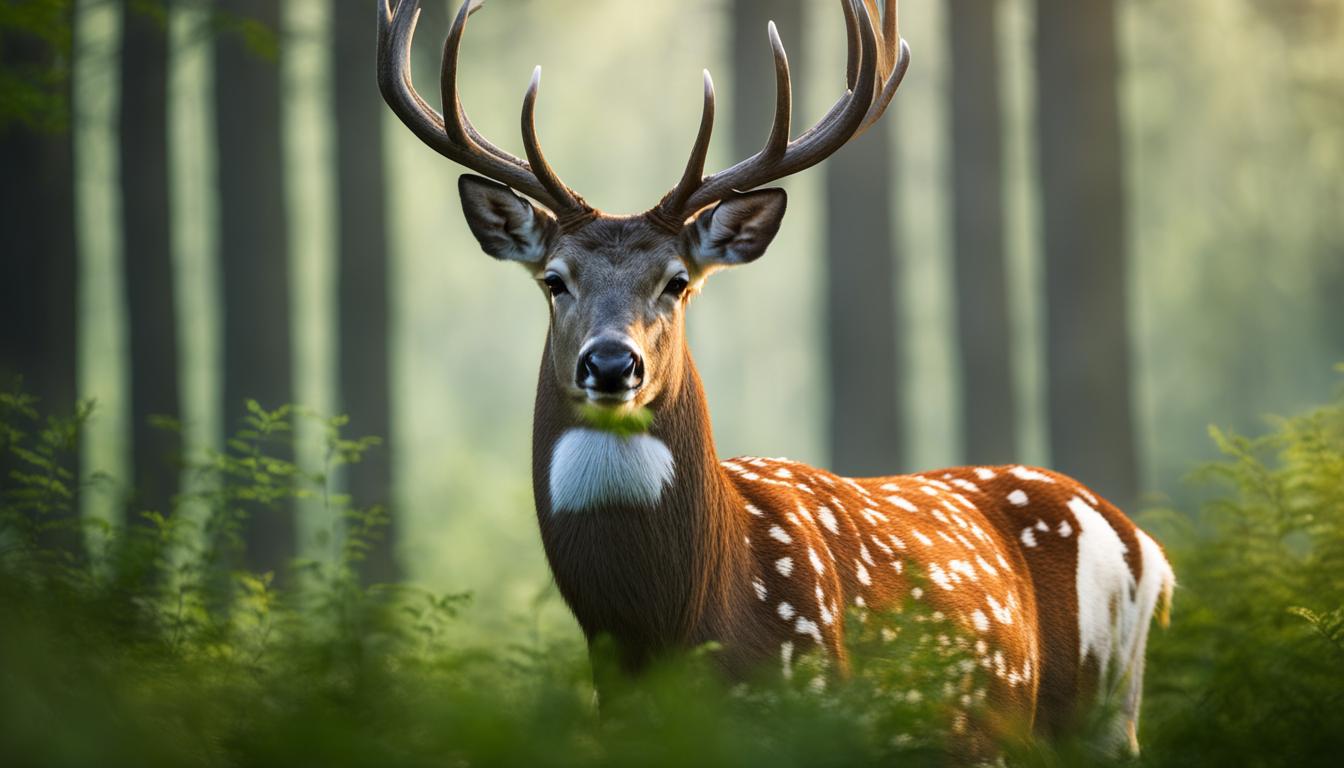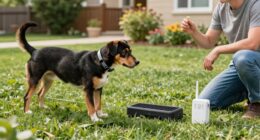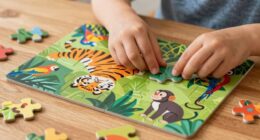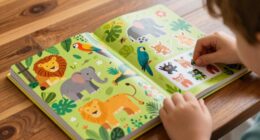Are you aware that taking care of baby deer, also known as fawns, requires special attention to guarantee their health and welfare? Whether you encounter an abandoned fawn or are interested in caring for a fawn in need, it is crucial to know the proper care methods. By offering the correct nutrition, establishing a secure environment, and fostering important bonding moments, you can give these charming animals a chance to thrive in life.
Key Takeaways:
- Proper nutrition, such as colostrum, is crucial for the immune system development of baby deer.
- Nurturing the bond between fawns and their mothers is important for their survival and well-being.
- Supplements like vitamin E, oral antibiotics, and probiotics can support the growth and health of fawns.
- Bottle feeding guidelines, including the right milk replacer, must be followed to ensure proper nutrition.
- Stimulating bowel movements and providing access to water and solid food are necessary for fawn development.
The Importance of Colostrum for Baby Deer Health
When it comes to the health of baby deer, colostrum plays a crucial role. Colostrum is the first milk produced by mothers after giving birth, and it provides essential antibodies that protect fawns from diseases and support the development of their immune system. Lack of colostrum can have severe consequences for newborn fawns, including digestive issues, respiratory problems, and even death.
Colostrum contains high levels of immunoglobulins, which are specialized proteins that help fend off infections and boost the immune response in fawns. These antibodies are crucial during the early stages of life when the fawn’s immune system is still developing and vulnerable.
“Colostrum is like a shield of protection for baby deer. It equips them with the necessary defenses to combat diseases and promotes overall health and well-being,” says Dr. Sarah Mitchell, a wildlife veterinarian with expertise in fawn care.
Ensuring that newborn fawns receive colostrum is essential for their long-term health and survival. Ideally, fawns should receive colostrum from their mothers within the first few hours after birth. However, there are situations where the mother may not be able to nurse or the fawn may be orphaned.
Alternative sources of colostrum can include milking out does or using colostrum from other farm animals, such as cows or goats. It is important to note that while these alternatives can provide some level of protection, they may not have the same composition of antibodies as deer colostrum.
Table: Comparison of Colostrum Sources
| Source | Advantages | Disadvantages |
|---|---|---|
| Deer Colostrum | Contains species-specific antibodies | May be difficult to obtain |
| Goat Colostrum | Easily accessible and widely available | Composition may differ from deer colostrum |
| Cow Colostrum | Easy to obtain and has high antibody content | Composition may differ from deer colostrum |
While providing colostrum from alternative sources can help bridge the gap when the mother is unavailable, it is crucial to consult with a wildlife rehabilitator or veterinarian to ensure the proper amount and administration. They can guide you on the best course of action and address any concerns or questions you may have.
Nurturing the Bond Between Fawns and Does
Allowing fawns and does to bond and nurse is essential for their physical and emotional well-being. The bond between a fawn and its mother is crucial for their survival. However, in cases where the mother fails to claim the fawn or the fawn doesn’t nurse, alternative methods such as tubing with colostrum or bottle feeding can be used. It is important to mimic the natural nursing behavior to ensure proper nutrition and bonding.
When fostering the bond between fawns and does, it is crucial to understand their natural behaviors and provide a nurturing environment. This encourages the development of a strong fawn-doe relationship, which is vital for the fawn’s growth and future interactions with other deer.
Benefits of Bonding and Nursing
The bond between fawns and does extends beyond physical care. It helps establish a social structure within the deer population, as well as provides the fawn with a sense of security and protection. Bonding and nursing also contribute to the fawn’s immune system development, as the doe’s milk contains essential nutrients and antibodies.
“The bond between fawns and does is a critical component of their well-being. It nurtures their physical health, emotional stability, and overall growth.” – Wildlife Expert
During nursing sessions, fawns learn important communication and socialization skills from their mothers. They also develop their sense of taste, as they become familiar with the doe’s unique milk composition. This knowledge helps them recognize and utilize forage and other sources of nutrition as they grow older.
Mimicking Nursing Behavior
When supplementing nursing through alternative methods, such as tubing or bottle feeding, it is essential to mimic the natural nursing behavior as closely as possible. This means ensuring the fawn is in a comfortable and secure position, using a nipple or tube that resembles the doe’s teat, and allowing the fawn to nurse at its own pace.
By replicating the natural nursing behavior, the fawn receives not only the necessary nutrition but also the emotional connection that is crucial for its development and well-being.
Benefits of Bonding and Nursing
| Benefits | Description |
|---|---|
| Physical Health | Nursing provides essential nutrients and antibodies for the fawn’s growth and immune system development. |
| Emotional Stability | Bonding with the doe fosters a sense of security and belonging for the fawn. |
| Socialization Skills | Nursing sessions allow fawns to learn communication and socialization skills from their mothers. |
| Sense of Taste | Fawns become familiar with the doe’s milk, expanding their palate and enabling them to recognize suitable food sources. |
Creating an environment that encourages bonding between fawns and does is a crucial aspect of fawn care. This can be achieved by providing a quiet and secure space for nursing, ensuring the doe feels safe and comfortable, and avoiding unnecessary disturbances.

Providing Essential Supplements for Baby Deer
When it comes to the care of baby deer, proper nutrition is key to their growth and development. Along with colostrum, which provides essential antibodies and nutrients, baby deer may require additional supplements to support their immune system and prevent deficiencies. Here are some important supplements to consider:
Vitamin E/Se for Fawns
To prevent vitamin E deficiencies, which can lead to muscle weakness and neurological issues, it is recommended to provide baby deer with vitamin E or selenium supplements. These supplements help support their overall health and promote proper growth. Consult with a local veterinarian to determine the appropriate dosage and best method of supplementation.
Oral Antibiotics for Fawns
In certain cases, such as high-risk fawns or those at risk of infection, oral antibiotics may be necessary. These antibiotics help prevent and treat bacterial infections, ensuring the well-being of the fawns. It is crucial to work closely with a veterinarian to determine if antibiotic treatment is needed and to administer the correct dosage.
Probiotics for Baby Deer
Probiotics play a vital role in maintaining a healthy gut microbiome in baby deer. These beneficial bacteria aid in digestion, improve nutrient absorption, and support overall gastrointestinal health. Incorporating probiotics into the fawns’ diet can help prevent digestive issues and promote a healthy immune system. Speak with a veterinarian to choose the appropriate probiotic supplement and ensure proper administration.
Remember, it is essential to consult with a local veterinarian who specializes in wildlife or deer care to determine the specific needs of baby deer in your region. They can provide expert guidance on the best supplements, dosages, and administration methods for optimal fawn health.
“By providing essential supplements, such as vitamin E, oral antibiotics, and probiotics, we can enhance the well-being and overall health of baby deer, ensuring they thrive in their natural habitats.”
| Supplement | Benefits |
|---|---|
| Vitamin E/Se | Prevents deficiencies, supports muscle strength and neurological health |
| Oral Antibiotics | Prevents and treats bacterial infections to ensure fawn well-being |
| Probiotics | Promotes healthy gut bacteria, aids digestion, and strengthens the immune system |
“Supplements like vitamin E, oral antibiotics, and probiotics are crucial for the healthy development and well-being of baby deer.”

Bottle Feeding Guidelines for Baby Deer
When fawns need to be raised without their mothers, bottle feeding becomes essential for their survival and growth. This section provides guidelines for successfully bottle feeding baby deer and ensuring they receive the nutrition they need.
The recommended feeding schedule for baby deer is 2 to 4 ounces of milk replacer five times a day during the first week or so. This frequent feeding ensures that the fawns receive adequate nourishment to support their rapid growth and development.
As the fawns grow older, the number of feedings can gradually be reduced. It is important to observe the individual needs of each fawn and adjust the feeding schedule accordingly. Introducing solid foods can also be done gradually, starting around 2 weeks of age.
When bottle feeding baby deer, it is crucial to use a formula specifically designed for fawns or goat milk replacer. These formulas provide the necessary nutrients for their growing bodies. Ensure that the milk replacer is at the proper temperature, around 100-105°F (38-40°C), to mimic the natural warmth of a mother’s milk.
Important Tips for Bottle Feeding Baby Deer:
- Hold the fawn securely and position the bottle at a slight angle, aiming the nipple towards the roof of its mouth.
- Allow the fawn to nurse naturally, avoiding forceful feeding that may lead to choking or aspiration.
- Observe the fawn’s behavior during feeding, ensuring it is drinking without difficulty and swallowing properly.
- Clean and sterilize all feeding equipment after each use to prevent the risk of contamination and potential health issues.
- Monitor the fawn’s weight gain and overall health. Seek veterinary assistance if you notice any concerning changes or issues.
Remember, bottle feeding baby deer requires patience, care, and attention to detail. By following these guidelines, you can provide these vulnerable creatures with the nourishment they need to thrive and grow.

Stimulating Bowel Movements in Baby Deer
During the first few weeks of a baby deer’s life, they often require assistance in stimulating bowel movements. This is necessary to keep their digestive system functioning properly and prevent issues such as constipation or diarrhea. By gently rubbing their genital area with a warm wet cloth while feeding, you can help stimulate their bowel movements.
It is important to approach this task with care and gentleness to ensure the comfort of the fawn. By using a soft cloth and applying gentle pressure, you can mimic the natural licking behavior of their mother. This stimulation encourages the muscles in their digestive tract to contract, facilitating the passage of waste through their system.
“Gently rubbing the genital area with a warm wet cloth during feeding helps stimulate bowel movements in baby deer.”
Regular bowel movements are crucial for the overall health of the fawn and can help prevent digestive issues. Insufficient or irregular elimination can lead to discomfort, bloating, and even digestive complications. By incorporating this simple practice into their care routine, you can contribute to their well-being and happiness.
Preventing Digestive Issues
By keeping baby deer regular and promoting healthy bowel movements, you can help prevent digestive issues. Constipation can occur when waste material becomes hard and difficult to pass, causing discomfort and pain. On the other hand, diarrhea can result from irregular bowel movements, leading to dehydration and nutrient deficiencies.
Regular gentle stimulation along with a proper diet and adequate hydration can go a long way in preventing these problems. It is also important to observe the fawn’s behavior and consult a veterinarian if you notice any persistent issues or abnormalities.
Remember to always handle baby deer with care and respect their delicate nature. They rely on us for their well-being, and by providing the necessary attention to their bowel movements, we can ensure their continued health and happiness.
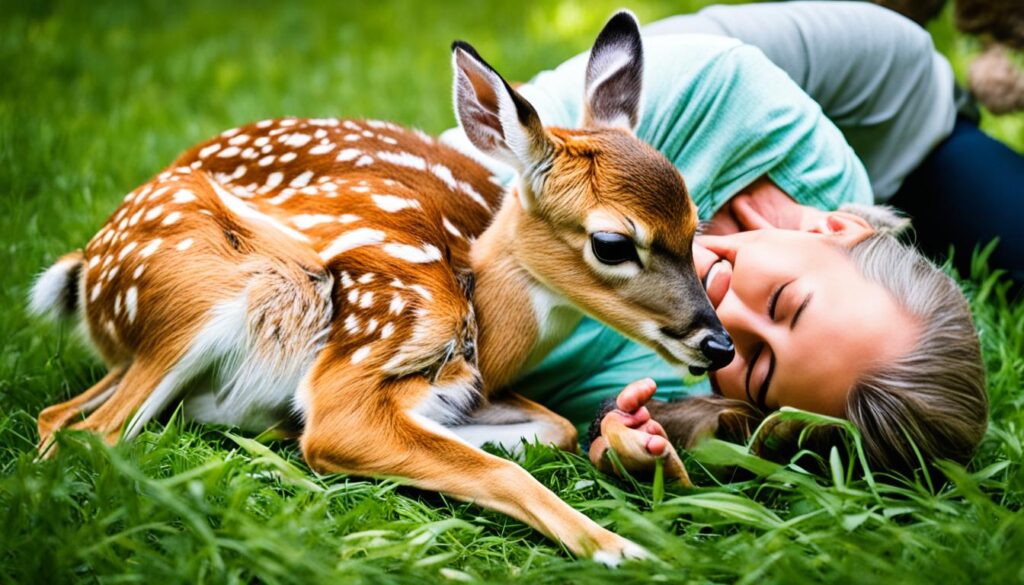
| Benefits of Stimulating Bowel Movements in Baby Deer | Preventive Measures for Digestive Issues |
|---|---|
|
|
Providing Water and Solid Food for Growing Fawns
Along with milk, baby deer should have access to fresh, clean water from a small bowl. Gradually, small amounts of solid food can be introduced to support their growth and development.
The introduction of solid food is an important milestone for fawns as it helps them transition to a more varied diet. Solid food provides essential nutrients and contributes to overall fawn growth.
Baby deer can be offered deer ration, which is specifically formulated to meet their nutritional needs. Alternatively, chopped carrots and apples can be provided as a natural source of nourishment. It’s important to start with small quantities and observe the fawn’s reaction and digestion before increasing the amount.
Adding selective greens, such as clover or dandelion leaves, can also provide valuable nutrients. Additionally, offering clean dirt can help fawns obtain minerals that contribute to their overall health.
It is crucial to ensure that the food and water provided to fawns are fresh and clean. Regularly clean and replenish the water bowl to prevent the buildup of bacteria or contaminants. Similarly, monitor the solid food for freshness and remove any spoiling or uneaten portions.
Remember, while introducing solid food is important, milk should still be the primary source of nutrition for baby deer. Gradually increase the proportion of solid food as the fawn gets older and can handle the dietary transition.
Proper nutrition is essential for the healthy growth of fawns. Providing clean water and introducing appropriate solid food are crucial steps in ensuring their overall well-being.

The Benefits of Providing Water and Solid Food for Growing Fawns:
- Supports healthy growth and development
- Provides essential nutrients and minerals
- Helps fawns transition to a varied diet
- Contributes to overall fawn health and well-being
Separating Fawns and Ensuring Safety
When it comes to caring for baby deer, separating fawns is a crucial step to prevent the spread of diseases and ensure the well-being of each individual. By providing separate fawn pens and implementing proper hygiene practices, you can minimize the risk of disease transmission and promote a healthy environment for the fawns to thrive.
Separate fawn pens provide a controlled space where each fawn can be monitored closely and attended to according to their specific needs. This prevents overcrowding and reduces the chances of disease transmission through direct contact or sharing of resources.
Proper hygiene practices are essential in fawn pens to maintain a clean and disease-free environment. Regularly cleaning the pens, equipment, and feeding areas helps prevent the buildup of infectious agents and promotes the overall health of the fawns.
Implementing Hygiene Practices:
- Regularly clean and disinfect the fawn pens using animal-safe disinfectants.
- Provide fresh bedding materials to minimize the risk of bacterial and parasitic infestation.
- Wash feeding equipment, such as bottles and nipples, thoroughly after each use to prevent the growth of harmful bacteria.
- Use disease-free colostrum or milk replacer to avoid introducing pathogens to the fawns’ digestive systems.
By following these hygiene practices, you can significantly reduce the risk of disease transmission and provide a safe environment for the fawns to grow and develop.
Mixing fawns in small groups can be done once they reach an appropriate age and growth stage. This allows them to socialize and learn essential behaviors from each other while minimizing the risk of disease transmission. However, it is important to monitor the fawns closely during the introduction phase and ensure that each fawn is healthy and displaying normal behavior.

Signs of a Fawn in Need of Assistance
Fawns are rarely orphaned, and it is important to avoid unnecessary intervention unless there are clear signs of distress or abandonment. While it can be heartbreaking to see a seemingly abandoned fawn, their mothers are often nearby, watching from a distance. However, there are certain signs that indicate when a fawn is in trouble and requires help.
1. Constant Crying: If you come across a fawn that is crying incessantly, it may be a sign that they are in distress. This could indicate that they are injured, hungry, or in need of assistance. Pay attention to their vocalizations and observe their behavior to determine if further action is necessary.
2. Approaching Humans: Fawns are naturally wary of humans and will usually keep their distance. If you encounter a fawn that approaches you or allows you to get too close, it could be a sign that they are in distress or have been abandoned. Their trust in humans suggests that they are seeking help and should be assessed by a professional.
3. Crumpled Ear Tips: Healthy fawns have upright, pointed ears. If you notice that a fawn’s ear tips are crumpled or folded over, it could indicate a health issue or injury. This physical abnormality is often a sign of distress and should be taken seriously.
4. Uncleanness: Fawns typically groom themselves and keep their fur clean. If you observe a fawn that appears dirty, matted, or covered in feces, it may be a sign of neglect or an inability to care for themselves. This could be due to abandonment or an underlying health condition that requires attention.
5. Clusters of Ticks around the Eyes: Ticks are common parasites that can infest fawns. However, if you notice a large number of ticks concentrated around a fawn’s eyes, it may indicate a weakened state or an inability to remove the ticks themselves. Excessive tick infestation can lead to anemia and other health complications.
If you come across a fawn exhibiting any of these signs, it is crucial to act promptly and contact a permitted wildlife rehabilitator. These professionals have the expertise and resources to assess the situation, provide appropriate care, and determine the best course of action for the fawn’s well-being.
Note: While it is essential to help fawns in need, it is equally important to avoid unnecessary intervention. Interfering with healthy fawns can disrupt their natural development and limit their chances of survival. Always consult with a professional before attempting any fawn rescue.

Conclusion
Caring for baby deer requires attention to their specific needs, such as providing colostrum, proper nutrition, and a safe environment. By following these tips and seeking professional advice when needed, you can contribute to the health and well-being of fawns. Remember to always prioritize the welfare of these precious creatures and respect their natural instincts and behaviors.
Providing colostrum is crucial for the development of their immune system and overall health. It is essential to make sure newborn fawns receive this vital source of antibodies either from their mothers or alternative sources.
Additionally, proper nutrition is key to supporting their growth. Along with milk replacer formulas, introducing solid foods and supplements like vitamin E can ensure they receive the necessary nutrients. It is important to consult a local veterinarian for guidance on their specific dietary needs.
Creating a safe environment is equally important. Separating fawns to prevent disease transmission, stimulating bowel movements, introducing water and solid food gradually, and recognizing signs of distress are vital for their well-being. By implementing these measures, you can contribute to the healthy development of baby deer and give them the best chance at thriving in the wild.



